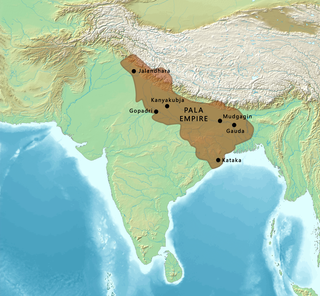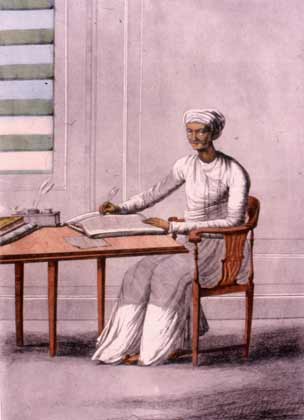Related Research Articles

The Pāla Empire was an imperial power during the post-classical period in the Indian subcontinent, which originated in the region of Bengal. It is named after its ruling dynasty, whose rulers bore names ending with the suffix Pāla. The empire was founded with the election of Gopāla as the emperor of Gauda in late eighth century CE. The Pala stronghold was located in Bengal and eastern Bihar, which included the major cities of Gauḍa, Vikramapura, Pāṭaliputra, Monghyr, Somapura, Ramavati (Varendra), Tāmralipta and Jaggadala.
Dewan designated a powerful government official, minister, or ruler. A dewan was the head of a state institution of the same name. Diwans belonged to the elite families in the history of Mughal and post-Mughal India and held high posts within the government.

The Sena dynasty was a Hindu dynasty during the early medieval period on the Indian subcontinent, that ruled from Bengal through the 11th and 12th centuries. The empire at its peak covered much of the north-eastern region of the Indian subcontinent. The rulers of the Sena Dynasty traced their origin to the south Indian region of Karnataka.

The history of Bengal is intertwined with the history of the broader Indian subcontinent and the surrounding regions of South Asia and Southeast Asia. It includes modern-day Bangladesh and the Indian states of West Bengal, Tripura and Assam's Karimganj district, located in the eastern part of the Indian subcontinent, at the apex of the Bay of Bengal and dominated by the fertile Ganges delta. The region was known to the ancient Greeks and Romans as Gangaridai, a powerful kingdom whose war elephant forces led the withdrawal of Alexander the Great from India. Some historians have identified Gangaridai with other parts of India. The Ganges and the Brahmaputra rivers act as a geographic marker of the region, but also connects the region to the broader Indian subcontinent. Bengal, at times, has played an important role in the history of the Indian subcontinent.
Taluqdars or Talukdar, were aristocrats who formed the ruling class during the Delhi Sultanate, Bengal Sultanate, Mughal Empire and British Raj. They were owners of a vast amount of lands, consistently hereditary, and were responsible for collecting taxes. The Taluqdars played helpful roles in the progression of Indian architecture and Indian economy during the reign of Emperor Shah Jahan and Aurangzeb, particularly in Bengal Subah, the most economically developed province in South Asia.

Bengali Brahmins are the community of Hindu Brahmins, who traditionally reside in the Bengal region of the Indian subcontinent, currently comprising the Indian state of West Bengal and the country of Bangladesh.
Mukherjee, also Mukerjee, Mookerjee, Mukerji, Mukherji, Mukhujje or Mookherjee, is a Bengali Hindu Kulin Brahmin surname originating from the Bengal region of the Indian subcontinent. The traditional Bengali version is Mukhopaddhae, which is sometimes written Mukhopadhyay.

Mohyal Brahmins are an Indian sub-caste of Saraswat Brahmins from the Punjab region.

Bikrampur was a pargana situated 19 kilometres (12 mi) south of Dhaka, the modern capital city of Bangladesh. In the present day, it is known as the Munshiganj District of Bangladesh. It is a historic region in Bengal and was a part of the Bhawal Estate.

Nabadwip, also spelt Navadwip, anciently Nadia or Nudiya, is a heritage city in Nadia district in the Indian state of West Bengal. It is regarded as a holy place by Hindus, and is the birthplace of Chaitanya Mahaprabhu. Famous for Rass festival where city is illuminated with lights, dieties of God and goddesses are made on each corner of Nabadwip town. Hundreds of people gather to this small town on the occasion of raas utsab. Located on the western bank of the Hooghly River, it is considered to have been founded in 1063 CE, and served as the old capital of the Sena dynasty. A center of learning and philosophy in medieval India, the city is still noted for its traditional Sanskrit schools. The Navya Nyaya school of logic reached its peak with the efforts of some well known contemporary philosophers of Nabadwip. The great Vaishnava saint, social reformer and an important figure of the Bhakti movement, Chaitanya Mahaprabhu (1486–1534) was born here. It was after Chaitanya Mahaprabhu's birth that Nabadwip became an important center of pilgrimage for the Vaishnavas worldwide as well as for Hindus in general. Many who follow Gaudiya Vaishnavism visit Nabadwip to celebrate the auspicious birthday day of Shri Mahaprabhu, which, as per lunar calculations, occurs on Phalguni Purnima. This day is commonly known as Gaura-purnima. Aside from this, Nabadwip is visited for various other festivals like Dol Jatra and Rash purnima.
Adi Dharm refers to the religion of Adi Brahmo Samaj the first development of Brahmoism and includes those Sadharan Brahmo Samajists who were reintegrated into Brahmoism after the second schism of 1878 at the instance of Devendranath Tagore. This was the first organised casteless movement in British India and reverberated from its heart of Bengal to Assam, Bombay State, Punjab and Madras, Hyderabad, and Bangalore.
Ballāla Sena or Ballal Sen, also known as Ballal Sen in vernacular literature, was the second ruler of the Sena dynasty of Bengal region of the Indian subcontinent. He was the son and successor of Vijaya Sena, and ended the Pala Empire by defeating Govinda Pala.

Bhurshut or Bhurishreshtha was a medieval Bengali Hindu kingdom spread across what is now Howrah and Hooghly districts in the Indian state of West Bengal.
Baidya or Vaidya is a Bengali Hindu community located in Bengal. Baidyas, a caste (jāti) of Ayurvedic physicians, have long had pre-eminence in society alongside Brahmins and Kayasthas. In the colonial era, the Bhadraloks were drawn primarily, but not exclusively, from these three upper castes, who continue to maintain a collective hegemony in West Bengal.

Bengali Kayastha is a Bengali Hindu caste, and is one of the main subgroups of the Kayastha community. The historical caste occupation of Kayasthas throughout India has been that of scribes, administrators, ministers and record-keepers; the Kayasthas in Bengal, along with Brahmins and Baidyas, are regarded among the three traditional higher castes that comprise the "upper layer of Hindu society." During the British Raj, the Bhadraloks of Bengal were drawn primarily, but not exclusively, from these three castes, who continue to maintain a collective hegemony in West Bengal.

Suket State was one of the Princely states of India during the period of the British Raj. The capital of the state was Pangna. Its last ruler signed the accession to the Indian Union on 15 April 1948. Formerly it belonged to the States of the Punjab Hills and currently, it is part of the Indian state of Himachal Pradesh. The present-day Mandi district was formed with the merger of the two princely states of Mandi and Suket.
Hussaini Brahmin is a Mohyal Brahmin community of the Punjab-region.
Kulinism or Kulin Pratha is a practice that envisages an elite position within the varna/jati configuration, derived from spiritual and ritual purity. Upper castes in Bengal were divided into exogamous classes, with ritual status determined by lineage purity and family marital history, with Kulins having the highest status. The Kulagranthas or Kulapanjikas are the foundational narrative of kulinism in Bengal, detailing its development over centuries and focusing on kulina lineages and social interaction norms. The Kulapanjikas state that King Ballal Sena initiated Kulinism, which conferred titles of nobility upon the Brahmanas, Kayasthas, and Vaidyas in Bengal. According to texts, King Adisura invited Brahmins to settle in the region from Kanauj and designated them higher in social status. The texts further state that King Ballal Sena introduced kulinism, designating certain linage of Brahmins and Kayasthas with higher social status due to superior virtues and practices; This system further extended to Baidya jatis, not associated with Kanauj migration. It appears to have started among the Baidyas with attributes like riches, education, good actions, etc., which were standardised by Samajapatis, Kulapanjikaras, and Ghatakus, as suggested by Sircar. Lakshmana Sena, the son and heir of Ballala Sena, is said to have made additional changes and controls to the establishment of kulinism. It is worth noting that the accounts of Kulpanjis in connection to kulinism are viewed with suspicion and have largely been accepted as unhistorical by scholars.